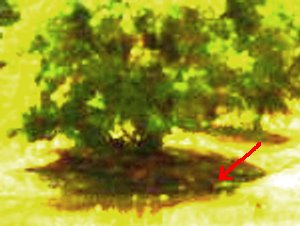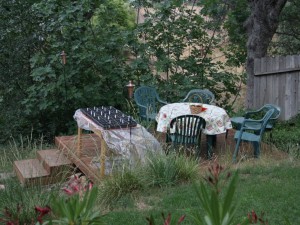We tested near two corners of the lawn, an irregular half of which is to become the new veggie plot.
The N center of the garden is the NE corner of the lawn and is the sunniest. It was originally the lowest point so it has the most fill dirt.
The SW corner is the shadiest. The lawn there is mostly moss. It was originally the highest point so there may not be much topsoil over the subsoil.
| Location |
Area |
pH |
N |
P |
K |
Elements |
Fertilizer |
Amendments |
| N center |
350 sq ft (veggies) |
6.7/good |
0/depleted |
1/deficient |
5/surplus |
32.5oz N plus 20.1oz P |
7.5lbs 16-16-16 and 3 lbs 26-3-4. Rototilled into veggie patch but only scattered onto lawn. |
6 cu ft compost rototilled in with the fertilizer, then 6 cu ft compost raked in. |
| SW corner |
350 sq ft (lawn) |
6.5/good |
0/depleted |
3/sufficient |
5/surplus |
none |
The 700 sq ft to be fertilized includes both the new veggie patch and the remaining portion of the lawn. Each is about 350 sq ft. For simplicity we applied the same fertilizers throughout despite the differing phosphorus levels. We applied fertilizers containing unneeded potassium because they were much less expensive than fertilizers without potassium.

A table in "Provençe"
We said farewell to friends with a picnic at Blackberry Cottage on Sunday afternoon. We’ll miss these dear people during our five-month stay in Seattle. Since we had been extremely busy preparing for the trip, we knew our menu for the picnic would have to be simple. Mike thought a French country theme might suit a menu of tomato soup, bread, cheese, and fruit.
Since last year’s changes at the cottage, I have no idea where the picnic supplies, such as table cloths, have been stored, and there is little temptation to search for them in the over-stuffed garage. At home, though, I found a striped blue and white sheet and laundered it to make a cover for the venerable picnic table. Over that I placed blue-and-white tea towels as “place mats.” The picnic china was culled from the cupboards at Bullion Street: light blue Italian soup bowls with a sort of peasant look to them, and some substantial old plates acquired in thrift shops. Grape leaves from the trellis and plates of fruit were the table decorations. If you squinted as you looked at the table, you might see a French Impressionist still life there.
While I set the table Mike was at Bullion Street warming up the soup (see “Recipes” category). He carried it over in a “straw box,” actually a wicker basket insulated with an old blanket. The swaddled soup stayed nicely warm. One of our friends surprised us with a fantastic coconut dessert, an ice “cream” made of coconut milk, an ambrosia of purest essence of coconut.
We stayed at table for more than two hours. Our friends enjoyed the soup and we raved over the coconut dessert. I don’t know if anybody saw Paul Cezanne in the table decorations, but I know that Mike and I savored this get-together with dear friends in “Provençe.”
We took a Thermos and two large china mugs when we went star-gazing last night near the intersection of Tiptop Road and Highway 49. Oak trees were silhouetted like black lace on the horizon. The sun-glow receded, and the inky sky revealed a million stars. The Big Dipper. Arcturus. The Scorpion.
Star-gazing and a Thermos are a tradition with us. Sometimes it’s hot soup. This time it was chocolate, and not the “instant” kind. It’s easy and economical to make hot chocolate from powdered cocoa, and the result is delicious and satisfying– without all the mystifying additives you find in the “instant” packets.
Recipes abound on the Internet and in cookbooks. I like the one in an old edition of the “Joy of Cooking,” and I pep it up by making it less dilute. Here’s how I make enough for two large mugs:
- 3/4 cup boiling water
- 1/4 cup cocoa
- 1/4 cup sugar
- a pinch of salt
- 2 1/4 cups scalded milk
In the top of a metal double-boiler I stir the dry ingredients together and add the hot water. I leave the pan over low direct heat for a minute as I continue to stir the mixture. Then I place it over the bottom half of the double-boiler, which contains the requisite amount of boiling water. Now I whisk in the hot milk. If there is time, I allow the mixture to continue to cook at moderate heat, covered, over the boiling water for 10 minutes. Then I give it a whisk and pour it into the Thermos.
Add stars and you have the recipe for a delicious evening.
Today was unusually cool for Mariposa in June. Overnight low was 55 and daytime temps were mostly in the low 70’s, briefly reaching 80 around 5pm.
We’re hopeful that the cool temperatures will encourage the lettuce we planted yesterday to germinate.
Purple Top, White Globe
Expected germination: 7-10 days
Expected harvest: 55 days
36 seeds
06/02: Planted 2 per cell in 18 cells.
06/06: 24 of 36 (67%) have shoots 1/4″ to 1″ tall.
06/10: 36 of 36 (100%) have shoots 1/4″ to 1-1/2″ tall.
06/14: 36 of 36 (100%) have shoots 1″ to 1-3/4″ tall.
06/19: Shoots are too dense to count and mostly 3″ to 3-1/2″ tall.
06/23: Planted out.
07/04: Thinned. Stalks chopped in soup. Leaves chopped and heated with salt, pepper, lemon, and sherry, then spread thickly on digestive biscuits as an appetizer.
07/18: 12″ to 17″ tall, with foliage diameters to 24″. Unfortunately shadowing parsnips.
07/19: Thinned one turnip and ate as turnip chips.
07/19: Hosed off as a precaution against aphids which we had found on related plants nearby.
07/22: Sprayed with 0.001% spinosad, an organic pesticide.
07/24: Approx 17″ tall, with foliage diameter approx 24″.
07/25: Started occasional harvest as they come ready.
08/01: Approx 13-22″ tall, with foliage diameter approx 24″. Several ready but too hot to eat turnips right now.
08/07: Approx 25″ tall, with foliage diameter approx 26″. Crowding parsnips. Occasional harvesting.
08/15: 18″ to 24″ tall, with foliage diameter approx 28″. 2″ to 3″ diameter. Harvest continues. Foliage looks healthy but seems to be starting to lie down.
08/23: Foliage lying down and going dormant. Three roots remain.
08/30: One roots remains.
09/02: Last root had been completely hollowed out by slugs, the only turnip thus affected.
Harvest: 53-92 days











Recent Comments